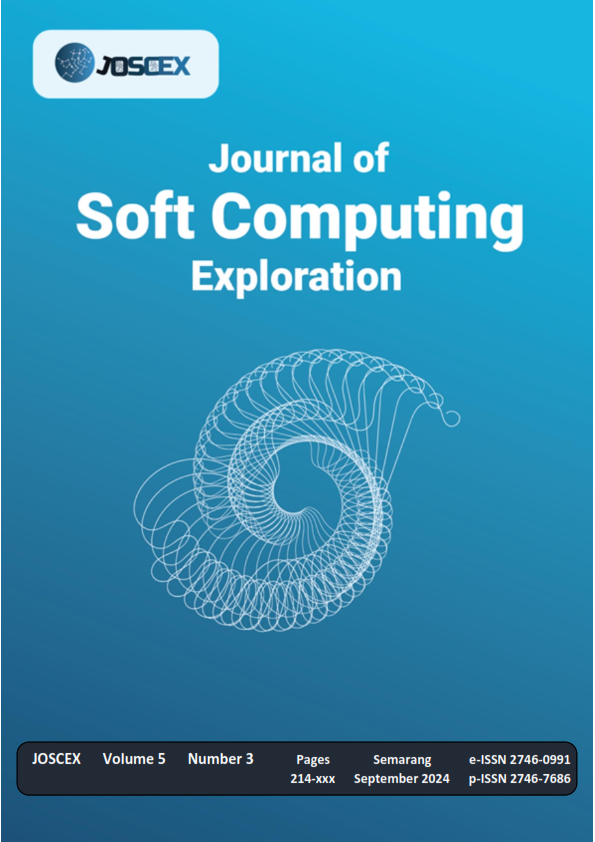Gabor wavelet and multiclass support vector machine for braille image classification
Main Article Content
Abstract
Braille is a letter designed for the visually impaired. As a family with normal vision who have a visually impaired child find it difficult to Teach their child how to learn and understand the process of learning from home. Learning braille requires good finger sensitivity and memory to memorize each letterform, making it difficult to learn. With this study, braille letters can be detected from the image using the Gabor Wavelet method to extract braille images and combined with the Multiclass Support Vector Machine (Multiclass SVM) algorithm as a classification method for extracted braille images. Data testing was performed using a confusion matrix to determine the level of precision, accuracy, and recall. According to the results of tests performed on 910 braille data using confusion matrix, the highest recognition accuracy was 98,02%. The accuracy of these results is impacted by the parameters of the training process, the training data, and the test data used. This research has the opportunity to be developed in voice-based card recognition to help the visually impaired in the future research.
Downloads
Article Details

This work is licensed under a Creative Commons Attribution-ShareAlike 4.0 International License.
References
M. R. Ningsih et al., “Sign Language Detection System Using YOLOv5 Algorithm to Promote Communication Equality People with Disabilities,” Sci. J. Informatics, vol. 11, no. 2, hal. 549–558, 2024, doi: 10.15294/sji.v11i2.6007.
S. Shokat, R. Riaz, S. S. Rizvi, A. M. Abbasi, A. A. Abbasi, dan S. J. Kwon, “Deep learning scheme for character prediction with position-free touch screen-based Braille input method,” Human-centric Comput. Inf. Sci., vol. 10, no. 1, 2020, doi: 10.1186/s13673-020-00246-6.
I. Sulviyani dan L. Novamizanti, “Perancangan Konversi Braille Ke Teks Berbasis Android,” ReTII, 2017.
R. Patmasari, S. Saidah, A. F. Akbar, dan R. Magdalena, “Design and Implementation of Learning Tools To Read the Braille Letters Based on Voice Processing and Arduino Using Mel Frequency Cepstral Coefficient and K-Nearest Neighbor Method,” J. Meas. Electron. Commun. Syst., vol. 6, no. 1, hal. 28, 2020, doi: 10.25124/jmecs.v6i1.2019.
A. AlSalman, A. Gumaei, A. AlSalman, dan S. Al-Hadhrami, “A Deep Learning-Based Recognition Approach for the Conversion of Multilingual Braille Images,” Comput. Mater. Contin., vol. 67, no. 3, hal. 3847–3864, 2021, doi: 10.32604/cmc.2021.015614.
I. G. Ovodov, “Optical Braille Recognition Using Object Detection Neural Network,” Proc. IEEE Int. Conf. Comput. Vis., vol. 2021-October, hal. 1741–1748, 2021, doi: 10.1109/ICCVW54120.2021.00200.
R. Goebel, “PRICAI 2019 : Trends in Series Editors,” Pricai, vol. 2, no. 61672281, hal. 431–444, 2019, doi: 10.1007/978-3-030-29894-4.
A. Iswara, A. M. Iswara, M. H. Purnomo, dan S. Sumpeno, “Aplikasi Pengenalan Kata pada Huruf Braille dan Pelafalannya,” J. Tekn Ik Pomits, vol. 2, no. 2, hal. A335–A340, 2013, [Daring]. Tersedia pada: http://ejurnal.its.ac.id/index.php/teknik/article/view/3408.
V. Jha dan K. Parvathi, “Braille transliteration of hindi handwritten texts using machine learning for character recognition,” Int. J. Sci. Technol. Res., vol. 8, no. 10, hal. 1188–1193, 2019.
R. F. Rahmat et al., “Braille letter recognition in deep convolutional neural network with horizontal and vertical projection,” Bull. Electr. Eng. Informatics, vol. 13, no. 5, hal. 3380–3391, 2024, doi: 10.11591/eei.v13i5.7222.
S. Ibrahim, N. A. Tarmizi, N. Sabri, N. F. Mohd Johari, dan A. F. Ahmad Fadzil, “Braille image recognition for beginners,” 2018 9th IEEE Control Syst. Grad. Res. Colloquium, ICSGRC 2018 - Proceeding, no. August, hal. 81–84, 2018, doi: 10.1109/ICSGRC.2018.8657490.
D. P. Sari, S. Rasyad, E. Evelina, dan A. Amperawan, “Identifikasi Huruf Braille Berbasis Image Processing Secara Real Time,” J. Ampere, vol. 2, no. 2, hal. 68, 2017, doi: 10.31851/ampere.v2i2.1765.
N. Azizah Ramadana dan A. Selao, “Aplikasi Penerjemah Huruf Braille Berbasis Android,” J. SINTAKS Log., vol. 4, no. 2, hal. 2775–412, 2024, [Daring]. Tersedia pada: https://jurnal.umpar.ac.id/index.php/sylog.
M. F. Herlambang, A. N. Hermana, dan K. R. Putra, “Pengenalan Karakter Huruf Braille dengan Metode Convolutional Neural Network,” Syst. Inf. Syst. Informatics J., vol. 6, no. 2, hal. 20–26, 2021, doi: 10.29080/systemic.v6i2.969.
R. Li, H. Liu, X. Wang, J. Xu, dan Y. Qian, “Optical braille recognition based on semantic segmentation network with auxiliary learning strategy,” IEEE Comput. Soc. Conf. Comput. Vis. Pattern Recognit. Work., vol. 2020-June, hal. 2362–2368, 2020, doi: 10.1109/CVPRW50498.2020.00285.
J. Unjung dan M. R. Ningsih, “Optimized Handwriting-based Parkinson ’ s Disease Classification Using Ensemble Modeling and VGG19 Feature Extraction,” Sci. J. Informatics, vol. 10, no. 4, hal. 489–498, 2023, doi: 10.15294/sji.v10i4.47108.
H. Hadiq, S. Solehatin, D. Djuniharto, M. A. Muslim, dan S. N. Salahudin, “Comparison of the suitability of the otsu method thresholding and multilevel thresholding for flower image segmentation,” J. Soft Comput. Explor., vol. 4, no. 4, hal. 242–249, 2023, doi: 10.52465/joscex.v4i4.266.
A. A. Hakim dan E. Juanara, “Mask Detection System with Computer Vision-Based on CNN and YOLO Method Using Nvidia Jetson Nano,” J. Inf. Syst. Explor. Res., vol. 1, no. 2, hal. 109–122, 2023.
E. Pirdia Wanti, A. Pariyandani, S. Zulkarnain Syed Idrus, dan A. Hasudungan Lubis, “Utilization of SVM Method and GLCM Feature Extraction in Classifying Fish Images with Formalin,” Sci. J. Informatics, vol. 8, no. 1, hal. 168–175, 2021, doi: 10.15294/sji.v8i1.26806.
M. R. Ningsih, “Classification Email Spam using Naive Bayes Algorithm and Chi-Squared Feature Selection,” vol. 9, no. 1, hal. 74–87, 2024.

